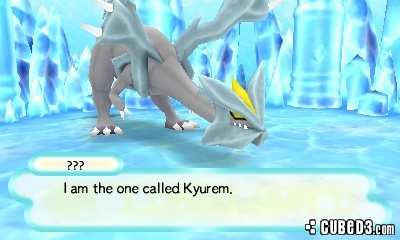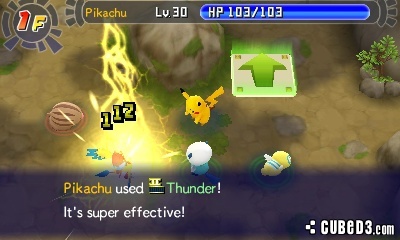Pokémon Mystery Dungeon: Gates to Infinity (Nintendo 3DS) Review
By SirLink  14.05.2013
14.05.2013

It's been roughly four years since the last Pokémon Mystery Dungeon game on the Nintendo DS, Pokémon Mystery Dungeon: Explorers of Sky. A new system opens up a lot of possibilities for this Pokémon spin-off series and while the jump from sprites to beautifully crafted 3D models and environments is immediately noticeable, is this game as a whole a worthy third instalment? Read on to find out…
The adventure starts out in a dream - the dream of the player - about a Pokémon in danger calling for help. After that, it's time to turn into a Pokémon. The charming personality quizzes of the previous games were removed in favour of a more direct approach; simply pick the Pokémon. Unfortunately, there are only five playable Pokémon in this game compared to the last game, which offered over a dozen options. The available choices are Pikachu, Snivy, Oshawott, Tepig and Axew. A partner has to be picked as well and it can be any of the remaining Pokémon.
Once that is done, the journey begins and - following the tradition of the Mystery Dungeon series - it's very much focused on the story. It's innocent and funny but also succeeds when it comes to evoking emotions from the player with some particularly sad and touching moments. This combination creates a narrative that's aimed at a younger audience but can also be enjoyed by open-minded adults, with recurring themes such as hope and friendship. A lengthy story obviously means lots of dialogue and while it's all well-written and entertaining to read, one bad design choice does hinder the experience ever so slightly. There is no option for the text speed and the default speed is quite slow. On top of that, it's not possible to advance or skip anything by pressing A or B. It's not a big flaw but it's still baffling that such an option wasn't included in a game that has tons of text to go through.

The hub world of the game is called Post Town and it contains various shops that sell items or offer helpful services, including a box to store items and money. On top of that, there's the Pokémon Paradise. The goal is to turn sectors of wasteland into a paradise by building many different facilities. Some examples for them are fields to grow more consumable seeds with various effects, dojos to train moves of certain types, shops or minigame stands. Fulfilling requests in dungeons is required to gain the necessary materials and money to expand the paradise. There are various different objectives for requests but the most common ones are rescuing a Pokémon, defeating a certain Pokémon or finding a specific item. Going on quests also raises the Paradise Rank, unlocking new types of facilities and more. While some requests have to be done to advance the plot, it's actually not mandatory to put a significant amount of effort into this addition to the series. It is a nice distraction and provides opportunities to obtain more helpful items to use in dungeons, though.
The other big part of the game takes place in the Mystery Dungeons. Up to four Pokémon can explore a dungeon together, while two of them have to be the hero controlled by the player and the partner. More Pokémon join as the storyline progresses but additional unrelated ones can join randomly when defeated in battle and will be sent back to the Pokémon Paradise if the party is already full. On average, the dungeons consist of a dozen floors. The layout is randomised, though there are some specific locations that will always look the same. To advance through the dungeons, one has to simply find the stairs but that's easier said than done as a lot of hostile Pokémon and traps get in the way.

Combat follows the same turn-based rule as the main series but still feels very different. Each action, like moving a space or using an item or attack takes up one turn. Most attacks only reach the space adjacent to the user, so most battles will be fought in close-range. Defeated Pokémon give experience to the whole group, regardless of whether they actually attacked or not. There's no battle transition either; it's all quick and seamless out in the open. While the hero Pokémon is controlled by the player, the AI will take care of everyone else. While there are set strategies such as "Follow Me," "Wait there," or "Go after foes" to assign to each member, the AI isn't all that bright when it comes to using the certain moves at the right time or on the right Pokémon. They also sometimes abandon the group to chase after a random Pokémon, despite the strategy saying otherwise. It's not a huge issue but better ally AI would certainly improve the experience. The dungeons are filled with items and if enemies picked one up, they will drop it when defeated. In the previous games, some actually used the items to their advantage but this didn't happen even once whilst reviewing this game. Items have a multitude of different uses, such as healing, reviving or causing status effects. While items can be found in dungeons, it's extremely helpful to always come prepared although some inventory slots should be kept free so found items don't have to go to waste.
Aside from hostile Pokémon, there are various other things to be found in dungeons. Traps don't appear frequently until later in the game but they can be extremely annoying. Triggered by stepping on a tile with an invisible trap on it, they can cause random status effects like sleep or paralysis, deal a lot of damage or even warp the affected Pokémon to a random spot on the floor. They are only a slight annoyance when the game is easy but once things get harder they can really mess everything up. Speaking of bad things, the monster houses from previous games return once again. Certain rooms will spawn around a dozen or more Pokémon once entered and they can be very dangerous, especially if the player becomes surrounded and has to endure several attacks each turn. Thankfully, items such as Petrify Orbs can disable all enemies in a room until they are attacked and grant an easy victory. These rooms also usually contain a lot of items and money and are well worth the trouble.
While there are dozens of dungeons accessible in the normal game, there is a new feature to essentially create endless dungeons. It uses the 3DS camera to summon Magnagates, which act as entrances to them. This can be done by scanning round objects or shapes. It works well enough, given sufficient lighting in the room. In this mode, players don't control the Pokémon from their main adventure but any items and money obtained will be transferred there. Rare items show up fairly regularly, so using this optional feature is quite rewarding indeed.

There are quite a few big changes between Gates of Infinity and its predecessors with the goal to make it more accessible to newcomers, which will please some fans and disappoint others. First off, the hunger system has been removed. It previously required players to bring or find food such as apples to essentially replenish their stamina. It was indeed more of a chore as running out of stamina caused the HP bar to go down until the Pokémon faints but its removal also made dungeons lose some of their sense of danger. The Attack Link system is also gone. It enabled linking together attacks to perform them all in a single turn, opening up good combos like Tail Whip to lower defence and then follow up with a physical attack immediately. Now, offensive attacks gain experience as they are used and level up themselves, increasing their power, PP and accuracy. These attack levels are shared between all Pokémon who know the move, too. Idle Pokémon will also gain the same experience as the ones who are out on a quest, making it much easier to switch parties around regularly.
Last, but not least, is the removal of the IQ system. Pokémon were assigned certain IQ groups and based on those they could learn helpful skills, like using items automatically, walking through otherwise inaccessible terrain and many other things. It took a lot of effort to raise the IQ to get the really good skills but it added more depth to the game. This was replaced by simple Team skills that can be obtained from treasure chests. Once acquired, they affect the entire party. On top of that, there are a lot less Pokémon to recruit. While the changes make the game more accessible, they also remove a lot of depth from the series. Particularly the absence of the Attack Link system is disappointing, as it enabled more much needed control over the AI companions and opened up more strategies. Thankfully the core gameplay mechanics are still intact and fun to play, even with the lingering feeling that something is missing.

Cubed3 Rating
Great - Silver Award

Much like the previous games, Pokémon Mystery Dungeon: Gates to Infinity is a rather niche title despite having the mighty Pokémon franchise behind it, as the dungeon-crawling gameplay and huge focus on an innocent, yet charming story don't have anywhere near as much mass appeal as the main series. Fans of the first two instalments and anyone who is interested in the concept of a well-written, story-driven Pokémon game with different gameplay should definitely give it a try, though. Despite its fair share of flaws, it's still a great experience and another quality title to add to the ever-growing Nintendo 3DS library.

Pokémon Mystery Dungeon: Magnagate and the Infinite Labyrinth
![]() 8/10
8/10
![]() 8/10
(1 Votes)
8/10
(1 Votes)
 Out now
Out now  Out now
Out now  Out now
Out now  Out now
Out now Comments
Comments are currently disabled

 Sign In
Sign In Game Details
Game Details Subscribe to this topic
Subscribe to this topic Features
Features





 Top
Top

